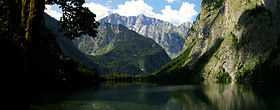Königssee
| Königssee | |
|---|---|
 View from Malerwinkel overlook | |
| Location | Schönau am Königssee, Bavaria, Germany |
| Coordinates | 47°33′N 12°58′E / 47.550°N 12.967°ECoordinates: 47°33′N 12°58′E / 47.550°N 12.967°E |
| Primary inflows | Schreinbach, Saletbach (from the Obersee), Kesselbach, Eisbach, Königsbach |
| Primary outflows | Königsseer Ache to Salzach |
| Basin countries | Germany |
| Max. length | 7.7 km (4.8 mi) |
| Max. width | 1.7 km (1.1 mi) |
| Surface area | 5.218 km2 (2.015 sq mi) |
| Average depth | 98.1 m (322 ft) |
| Max. depth | 190 m (620 ft) |
| Water volume | 511,785,000 m3 (414,911 acre·ft) |
| Surface elevation | 603 m (1,978 ft) |
| Islands | Christlieger |
| Settlements | Schönau am Königssee Ortsteil Königssee |
The Königssee is a natural lake in the extreme southeast Berchtesgadener Land district of the German state of Bavaria, near the border with Austria. Most of the lake is within the Berchtesgaden National Park.
Situated within the Berchtesgaden Alps in the municipality of Schönau am Königsee, just south of Berchtesgaden and the Austrian city of Salzburg, the Königssee is Germany's third deepest lake. Located at a Jurassic rift, it was formed by glaciers during the last ice age. It stretches about 7.7 km (4.8 mi) in the north-south direction and is about 1.7 km (1.1 mi) across at its widest point. Except at its outlet, the Königsseer Ache at the village of Königssee, the lake similar to a fjord is surrounded by steeply rising flanks of mountains up to 2700 m (8900 ft), including the Watzmann massif in the west. The railway Königsseebahn served the lake from 1909 until 1965. Its last tracks were dismantled during 1971, and the station in Berchtesgaden was torn down in 2012. The only remaining element of the railway is the Königsee station (now a restaurant). The track route is mostly used as a walking path.
The literal translation of the name, Königssee, appears to be "king's lake"; however while German: König does indeed mean "king", there had been no Bavarian kings since the days of Louis the German until Elector Maximilian I Joseph assumed the royal title in 1806. Therefore the name more probably stems from the first name Kuno of local nobles, who appear in several historical sources referring to the donation of the Berchtesgaden Provostry in the twelfth century; the lake was formerly called Kunigsee.[1]
In 1944 a sub-camp of the Dachau concentration camp was located nearby where Heinrich Himmler had a residence built at Schönau for his mistress Hedwig Potthast.[2]
The lake is noted for its clear water and is advertised as the cleanest lake in Germany. For this reason, only electric-powered passenger ships, rowing, and pedal boats have been permitted on the lake since 1909. Passenger services along the length of the lake, calling at various points, are operated by the Bayerische Seenschifffahrt company.[3][4] Ports of call for this monopolist are: Seelände (Schönau), St. Bartholomä, Salet (not served between mid-October until mid-April), and Kessel (on request). With perfect conditions, the longest tour takes two hours from Seelände to Salet.[5] Swimming is permitted except in the lock area at Seelände.
Due to its picturesque setting, the lake and surrounding parklands are very popular with tourists and hikers. In addition, the lake's position surrounded by sheer rock walls creates an echo, which is known for its clarity. On boat tours, it has become traditional to stop and play a flugelhorn or trumpet to demonstrate the echo. Formerly demonstrated by shooting a canon, it can be heard to reverberate up to seven times. The trumpeter plays along with the returning sounds so it sounds like as many as 7 multiple players.
St. Bartholomä, a famous pilgrimage church with an inn nearby, is located on a peninsula about halfway down the western lake shore. The small Christlieger island is located near its northern end. South of the Königssee, separated by the Salet moraine, is the smaller Obersee lake with the 470 m (1,540 ft) high Röthbach waterfall. As there is no lakeside path on the steep shore of the Königssee, St. Bartholomä and the southern edge can only be reached by boat or via hiking trails up the surrounding mountains—except for harsh winters, when the lake freezes over. Stepping on the ice, however, can be fatal, as it was for a motorist in the winter of 1964, who on his way back from St. Bartholomä drowned in his VW Beetle. The car was not detected until 1997 at a depth of about 100 m (300 ft).[6]
-

St. Bartholomä and Watzmann
-

An electric passenger launch at Schönau on the lake
-

Obersee
See also
References
- ↑ Bayerische Seenschifffahrt: FAQ
- ↑ (German) Der Spiegel 4/1967
- ↑ "Bayerische Seenschifffahrt". Bayerische Seenschifffahrt. Retrieved 2011-07-11.
- ↑ "Geschichtliche Hintergründe" [Historical Background] (in German). Bayerische Seenschifffahrt. Retrieved 2011-07-11.
- ↑ www.seenschifffahrt.de (German) Anlegestellen. Retrieved 2013-08-14.
- ↑ (German) taunuskaefer.de: Underwaterlove
External links
- Nixdorf, B.; et al. (2004), "Königssee", Dokumentation von Zustand und Entwicklung der wichtigsten Seen Deutschlands (in German), Berlin: Umweltbundesamt, p. 45
| Wikimedia Commons has media related to Königssee. |